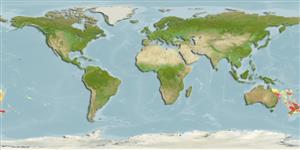Myxini (hagfishes) >
Myxiniformes (Hagfishes) >
Myxinidae (Hagfishes) > Eptatretinae
Etymology: Eptatretus: Greek, epta = seven + Greek, tretos, -e, -on = with holes (Ref. 45335).
Environment / Climate / Range
Ecology
Marine; bathydemersal; non-migratory; depth range 0 - 1100 m (Ref. 89422), usually 40 - 700 m (Ref. 31276). Deep-water, preferred ?
Western Pacific: southern and eastern Australia and New Zealand.
Size / Weight / Age
Maturity: Lm ? range ? - ? cm
Max length : 97.0 cm TL male/unsexed; (Ref. 101563)
Short description
Morphology | Morphometrics
Dorsal
spines
(total): 0;
Dorsal
soft rays
(total): 0;
Anal
spines: 0;
Anal
soft rays: 0. This species differs from all its congeners except E. caribbeaus, E. goliath,
E. menezesi and E. strahani by having 7 pairs of gill pouches and three-cusp multicusps on the anterior and posterior rows of cusps. It differs from E. caribbeaus in number of anterior unicusps (8-11 vs. 11-13), posterior unicusps (7-9 vs. 10-11), total cusps (43-51 vs. 54-58) and prebranchial pores (16-20 vs. 13-15); from E. goliath in number of anterior unicusps (8-11 vs. 11-13), total
cusps (43-51 vs. 54) and trunk pores (46-53 vs. 57-58); from E. menezesi in number of posterior unicusps (7-9 vs. 9-12), total cusps (43-51 vs. 52-60), tail pores (10-14 vs. 14-18); from E. strahani by its number of prebranchial pores (16-20 vs. 13-16) (Ref. 85052).
Occurs on soft bottoms of the continental slope (Ref. 7300). Able to form locally abundant populations and is often associated with inshore reefs (Ref. 85052).
Life cycle and mating behavior
Maturity | Reproduction | Spawning | Eggs | Fecundity | Larvae
Copulatory organ absent. The gonads of hagfishes are situated in the peritoneal cavity. The ovary is found in the anterior portion of the gonad, and the testis is found in the posterior part. The animal becomes female if the cranial part of the gonad develops or male if the caudal part undergoes differentiation. If none develops, then the animal becomes sterile. If both anterior and posterior parts develop, then the animal becomes a functional hermaphrodite. However, hermaphroditism being characterised as functional needs to be validated by more reproduction studies (Ref. 51361 ).
Fernholm, B., 1998. Hagfish systematics. p. 33-44. In J.M. Jørgensen, J.P. Lomholt, R.E. Weber and H. Malte (eds.) The biology of hagfishes. Chapman & Hall, London. 578 p. (Ref. 31276)
IUCN Red List Status (Ref. 115185)
CITES (Ref. 94142)
Not Evaluated
Threat to humans
Harmless
Human uses
More information
Age/SizeGrowthLength-weightLength-lengthLength-frequenciesMorphometricsMorphologyLarvaeLarval dynamicsRecruitmentAbundance
ReferencesAquacultureAquaculture profileStrainsGeneticsAllele frequenciesHeritabilityDiseasesProcessingMass conversion
Tools
Special reports
Download XML
Internet sources
Estimates of some properties based on models
Phylogenetic diversity index (Ref.
82805): PD
50 = 0.5000 [Uniqueness, from 0.5 = low to 2.0 = high].
Bayesian length-weight: a=0.00302 (0.00167 - 0.00545), b=2.94 (2.77 - 3.11), in cm Total Length, based on LWR estimates for this species & (Sub)family-body (Ref.
93245).
Trophic Level (Ref.
69278): 5.0 ±0.50 se; Based on food items.
Resilience (Ref.
69278): Low, minimum population doubling time 4.5 - 14 years (Fec assumed to be <100).
Vulnerability (Ref.
59153): Moderate to high vulnerability (52 of 100) .
